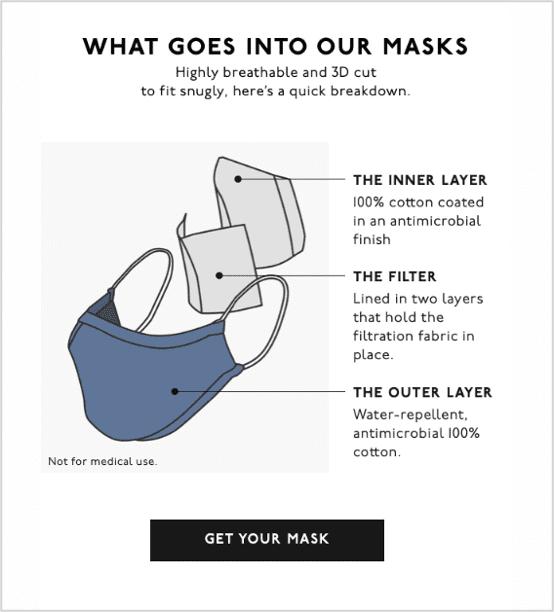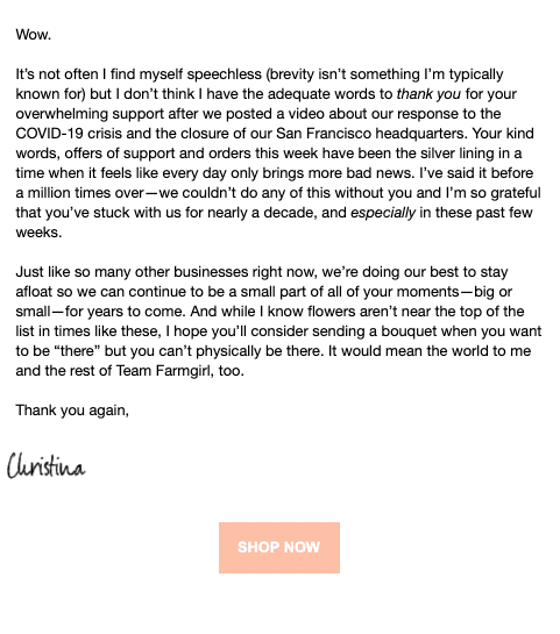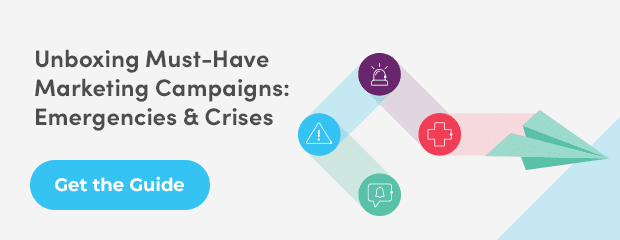In this ongoing series, we’ll be “unboxing” must-have digital marketing campaigns and programs vital to success. In this installment, we’ll look at emergencies and crises.
It’s on every marketer’s mind in 2020: How do you communicate with customers during an emergency or crisis?
While it’d be nice to have Olivia Pope on speed dial for a brand crisis or a designated business continuity team during a global pandemic, companies don’t always have that option.
Yet?
Growth marketers like you would love to have the confidence and skills to communicate during an emergency, so customers are happy, satisfied, and stay loyal to your brand when everything goes back to normal.
This is why we’re going to focus on emergency and crisis campaigns for this next edition of Unboxing Must-Have Marketing Campaigns.
Download the complete guide to learn the differences between an emergency and a crisis, as well as how to turn lemons into lemonade with the right cross-channel messaging.
As an introduction, let’s talk about the one principle you should keep in mind when communicating during an emergency.
The Power of a Single Overriding Communications Objective (SOCO)
Of course, each emergency or crisis situation presents its own set of unique challenges, but customers will generally:
- Ask questions
- Prod for status updates
- Voice their disapproval at your actions
- Take out their emotions on your brand (even when you’re not necessarily at fault)
So here’s a framework the Centers for Disease Control and Prevention (CDC) uses to communicate with the public during a health emergency.
It’s called a Single Overriding Communications Objective (SOCO).
The CDC specifically uses this framework to help brief their media spokespeople for press conferences, but we at Iterable have taken the liberty of modifying the five questions for sending cross-channel marketing campaigns.
The 5 Questions to Ask Before Communicating During a Crisis
- What is your primary message?
- What do you want your recipients to do?
- What lists or segments need to know about this?
- What facts or data points support the message?
- Who should “send” or be the spokesperson for this message?
Let’s break them down, one by one.
1. What is your primary message?
Determining your campaign’s primary message can be hard to do in general. But it gets especially more difficult during an emergency or crisis that is rapidly changing by the minute.
Maybe it’s notifying your customers that your stores are open for curbside pickup during a global pandemic.
Or you need to tell them that shipping times are delayed because your warehouse location is experiencing a hurricane.
Whatever it is, it’s important to remember that recipients are skimming, so you need to prioritize what information is most important for them to know.
For example, let’s take a look at the email campaign LastPass sent to users during the 2018 Under Armour data breach.


Password manager LastPass notifies customers about the Under Armour data breach.
While LastPass does an excellent job of stating upfront that user accounts are not affected by this data breach, the primary message gets lost as the email goes into detail about:
- How to protect yourself from a data breach incident
- What the meaning of a hashed password is
- Detailing information about the incident
If LastPass had eliminated some of the extraneous information by linking directly to Under Armour’s website or added a few line breaks, the primary message would be easier to read and understand.
However, this email still serves as a good example of why it’s essential to communicate with your customers directly about an emergency or a crisis—especially if customers are at risk.
2. What do you want recipients to do?
Figuring out what you want your recipients to do is otherwise known as deciding what your campaign’s primary call-to-action (CTA) should be.
B2C emails typically use CTAs like “Buy Now” or “Start Shopping.”
Except those CTAs can come off as insensitive during an emergency or a crisis, especially if they don’t mention the situation at hand and how it affects the customer.
For instance, take a look at the sales email Vanguard sent to its users amidst a volatile stock market during the COVID-19 outbreak.




Financial services company Vanguard invites investors to try their Digital Advisor program.
Even though Vanguard is asking for users to try its Digital Advisor program, take notice of how the email address the volatile stock market trends in the second paragraph:
“Navigating change is a fact of life. We reach milestones, breathe through market ups and downs, and watch seasons come and go. Through it all, our dreams for financial independence in retirement remain.”
Vanguard has been around since 1975, so there’s no question that the company has “watched the seasons come and go.” This email serves as a great example of how brands can still sell products and services with empathy during an emergency.
3. What lists or segments need to know about this?
We at Iterable have noticed that since the COVID-19 outbreak, our inboxes are filled to the brim with re-engagement emails.
This strategy often makes sense from a brand’s perspective. After all, it’s five to 25 times more expensive to acquire a new customer than retain an existing one.
But it can also come off as annoying to the customer, especially if it’s been years since they’ve heard from your brand. For contrast, let’s look at the following Alaska Airlines email sent during the COVID-19 outbreak.


Alaska Airlines allows a 6-month extension for using travel credits.
There was a ban on non-essential travel due to government-issued stay-at-home orders, so Alaska Airlines alerted any customer who had existing travel credits in their account that there was a 6-month extension on using them.
Also, note the empathetic language in the first paragraph:
“Right now, we want to make sure you have the flexibility and space to make the best decisions for you and your family.”
Compare that to other airlines, who sent a general thank you message about the comprehensive relief fund to anyone who’s ever booked a flight with them.
In general, it’s always a good idea to personalize your campaigns. But it’s even more important during an emergency or a crisis so your brand comes across as empathetic.
4. What facts or data points support this message?
According to crisis communications expert Doug Levy, you need three convincing details to make your primary message believable.
Using facts or data points adds legitimacy to your message without emotions attached to the emergency or crisis.
It also allows the recipient to validate whether the message is trustworthy or not.
For example, clothing retailer Madewell sent a promotional email stating that its non-medical grade face masks were ready for customers.


Clothing retailer Madewell promotes its new non-medical grade face masks.
However, Madewell is known for its cute and stylish clothing—not necessarily face masks. So in the next part of the email, Madewell describes the materials used to make each mask layer.


Madewell describes the materials used in their new non-medical grade face masks.
During the time this email was sent, the CDC had recently made recommendations to wear a mask to limit the potential spread of COVID-19.
Using facts in this email not only helps the recipient feel safe and secure that the product is reliable but also encourages the customer to browse the Madewell website for other clothing items.
5. Who should “send” or be the spokesperson for this message?
When your brand is deciding who should “send” or be the spokesperson for your campaign, it ultimately comes down to who your recipients trust the most.
According to crisis communications expert Doug Levy:
“People are much more likely to trust a person they know or have seen before. If there is no personal relationship, trust can be earned by a person who demonstrates that they give accurate information and have empathy for the audience.”
Either one of those elements will help with trust and credibility. But what if you found someone who was both familiar and empathetic?
Recently, Farmgirl Flowers CEO Christina Stembel went to her Instagram to ask for orders during the COVID-19 outbreak so she could continue to pay her employees amidst a county-wide shelter-in-place mandate.
The response was so overwhelming that afterward, she sent a thank you email to her customers.




Farmgirl Flowers’ CEO and Founder thanks customers for their support during COVID-19.
Brands don’t get a response like that from customers without trust. So it’s clear that using Stembel as a spokesperson for the brand’s response to the emergency or crisis was the right thing to do.
A Quick Recap on Emergencies and Crises
We at Iterable believe that while an emergency or a crisis can negatively impact your brand’s operations or bottom line, it can also:
- Allow companies the opportunity to offer new products and services
- Rethink operational procedures
- Remind past, present, and future customers why they should trust your brand with their business
However, it can be difficult to see that opportunity during the event itself. So that’s why we recommend relying on the Single Overriding Communications Objective (SOCO), which involves answering five questions before brands send out any marketing campaign or messaging:
- What is your primary message?
- What do you want your recipients to do?
- What lists or segments need to know about this?
- What facts or data points support the message?
- Who should “send” or be the spokesperson for this message?
Want to know how to use other cross-channel platforms, like SMS, in-app messaging or social media, during an emergency?
Download our full guide to learn what governments and nonprofits can teach brands about cross-channel messaging.
Now that you have the confidence and skills to send the right campaigns and messaging during an emergency or a crisis, what are you going to do to build trust with your customers?






























